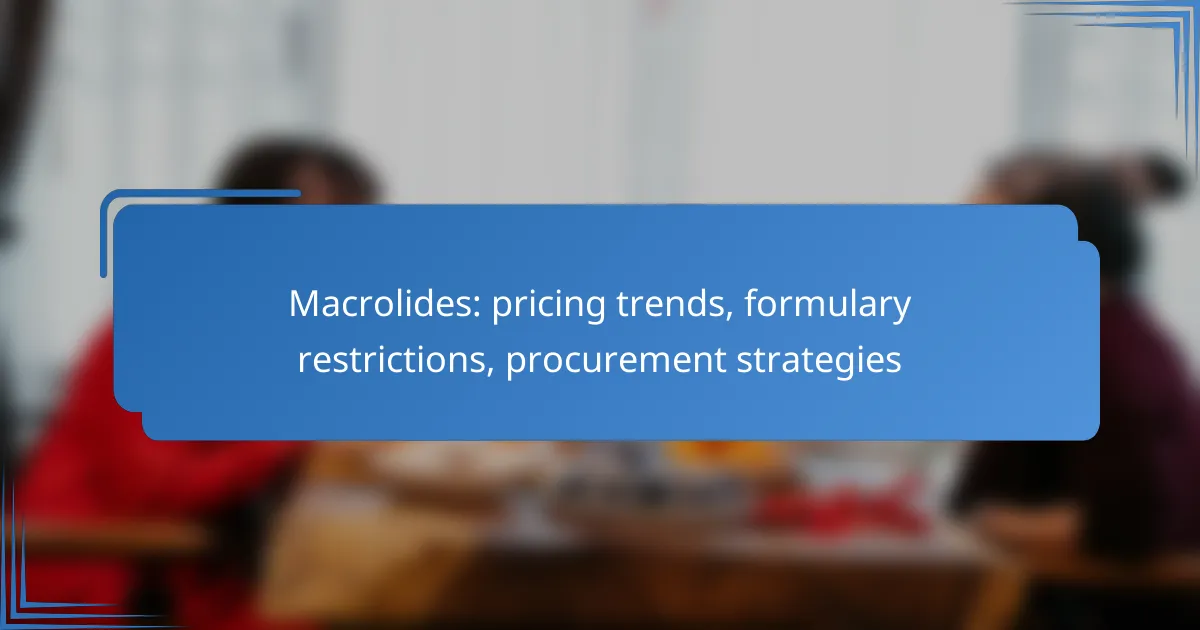Macrolides have experienced moderate pricing fluctuations in Canada, primarily driven by market demand, production costs, and regulatory changes. Formulary restrictions often impose specific coverage criteria under provincial drug plans, potentially impacting patient access. To enhance procurement strategies, healthcare providers can utilize bulk purchasing and negotiate with suppliers, ultimately leading to cost savings and improved access to these essential medications.

What are the current pricing trends for macrolides in Canada?
Pricing trends for macrolides in Canada have shown moderate fluctuations, influenced by factors such as market demand, production costs, and regulatory changes. Generally, prices have remained stable, with some variations depending on the specific drug and its availability.
Price fluctuations over the past year
Over the past year, macrolide prices in Canada have experienced slight increases, typically ranging from 5% to 10%. These fluctuations are often driven by changes in supplier pricing and shifts in demand, particularly during peak seasons for respiratory infections.
Monitoring these price trends is crucial for healthcare providers and pharmacies to ensure they are obtaining the best possible rates. Regularly reviewing supplier contracts can help mitigate unexpected cost increases.
Comparison of brand vs. generic macrolides
Brand-name macrolides tend to be priced significantly higher than their generic counterparts, often by 30% to 50%. This price difference is due to the brand’s marketing costs and patent protections, which allow for premium pricing.
However, generic macrolides offer a cost-effective alternative without compromising efficacy. Healthcare providers should consider prescribing generics when appropriate to reduce overall treatment costs for patients.
Impact of supply chain disruptions
Supply chain disruptions have impacted the availability and pricing of macrolides in Canada, leading to occasional shortages and increased prices. Factors such as global shipping delays and manufacturing issues can exacerbate these challenges.
To navigate these disruptions, pharmacies and healthcare facilities should establish strong relationships with multiple suppliers and maintain adequate stock levels to ensure patient access to necessary medications. Regularly assessing supply chain risks can help mitigate potential impacts on pricing and availability.

What formulary restrictions apply to macrolides in Canada?
In Canada, formulary restrictions for macrolides often involve specific criteria for coverage under provincial drug plans. These restrictions can affect patient access and may require prior authorization or adherence to certain clinical guidelines.
Common formulary restrictions by province
Formulary restrictions for macrolides vary across Canadian provinces. For example, in Ontario, macrolides may require prior authorization for certain indications, while British Columbia may have specific limits on quantity or duration of therapy. Alberta often mandates that patients try alternative antibiotics before macrolides are approved.
Criteria for inclusion in provincial drug plans
To be included in provincial drug plans, macrolides typically must demonstrate clinical efficacy and safety for specific conditions. Provinces may require evidence from clinical trials or guidelines that support their use in treating infections. Additionally, cost-effectiveness analyses are often considered to ensure that the benefits justify the expenses involved.

How can healthcare providers optimize procurement strategies for macrolides?
Healthcare providers can optimize procurement strategies for macrolides by leveraging bulk purchasing, negotiating effectively with suppliers, and utilizing group purchasing organizations. These strategies can lead to cost savings and improved access to essential medications.
Bulk purchasing options
Bulk purchasing allows healthcare providers to buy macrolides in larger quantities, which can significantly reduce costs per unit. This approach is particularly effective when anticipating high demand or when negotiating favorable terms with manufacturers.
Providers should assess their usage patterns to determine optimal order sizes. For instance, purchasing enough for several months can lead to discounts, but overstocking may result in waste if medications expire before use.
Negotiation tactics with suppliers
Effective negotiation with suppliers can yield better pricing and terms for macrolides. Providers should prepare by researching market prices and understanding their own purchasing power, which can enhance their bargaining position.
Consider discussing volume discounts, payment terms, and delivery schedules. Establishing long-term relationships with suppliers can also lead to more favorable conditions and priority access during shortages.
Utilizing group purchasing organizations
Group purchasing organizations (GPOs) can help healthcare providers access macrolides at lower prices by pooling purchasing power across multiple facilities. This collective approach often results in better contract terms and pricing than individual purchases.
Providers should evaluate different GPOs based on their specific needs and the range of products offered. Joining a GPO can streamline procurement processes and provide access to a wider selection of macrolides at competitive rates.

What are the key factors influencing macrolide pricing?
Macrolide pricing is primarily influenced by manufacturing costs, market demand, and competition. Understanding these factors can help stakeholders navigate procurement strategies effectively.
Manufacturing costs
The production costs of macrolides are a significant determinant of their market price. These costs include raw materials, labor, and overhead expenses associated with the manufacturing process. Variations in these costs can arise from changes in supply chain dynamics or regulatory compliance requirements.
For instance, if the price of active pharmaceutical ingredients (APIs) increases due to supply shortages, manufacturers may pass these costs onto consumers, resulting in higher prices for macrolides. Additionally, economies of scale can play a role; larger manufacturers may benefit from lower per-unit costs, potentially leading to more competitive pricing.
Market demand and competition
Market demand for macrolides can fluctuate based on factors such as disease prevalence and treatment guidelines. When demand is high, prices may rise, particularly if supply cannot keep pace. Conversely, if demand decreases, prices may drop as manufacturers seek to maintain sales volume.
Competition among pharmaceutical companies also affects pricing. In markets with multiple suppliers, prices tend to be lower due to competitive pressure. Conversely, in markets dominated by a few manufacturers, prices may be higher. Stakeholders should monitor these dynamics to make informed procurement decisions and negotiate better pricing.

How do macrolide formulary restrictions affect patient access?
Macrolide formulary restrictions can significantly limit patient access to these antibiotics, impacting treatment options and outcomes. When certain macrolides are not included on a formulary, healthcare providers may have to prescribe alternatives that may not be as effective or well-tolerated by patients.
Impact on prescribing practices
Formulary restrictions often lead to changes in prescribing habits among healthcare providers. Physicians may be compelled to prescribe alternative medications that are on the formulary, even if they are less suitable for the patient’s condition. This can result in increased treatment failures or adverse effects, as the alternatives may not match the efficacy of macrolides.
Additionally, prescribers might spend more time justifying their choices to insurance companies, which can delay necessary treatment. This administrative burden can discourage the use of effective therapies and lead to suboptimal patient care.
Patient adherence challenges
When macrolides are restricted, patients may face adherence challenges due to the need for alternative medications that could have different dosing schedules or side effects. For instance, if a patient is switched from a macrolide to a less tolerable antibiotic, they may be less likely to complete their treatment regimen.
Moreover, higher out-of-pocket costs associated with non-formulary drugs can further deter patients from adhering to their prescribed therapies. Ensuring that patients understand the importance of their medication and the reasons behind formulary restrictions can help mitigate some of these adherence issues.

What are the emerging trends in macrolide procurement?
Emerging trends in macrolide procurement focus on digital transformation and sustainability. These trends are reshaping how healthcare providers source and manage macrolide antibiotics, emphasizing efficiency and environmental responsibility.
Shift towards digital procurement platforms
The shift towards digital procurement platforms is revolutionizing macrolide sourcing by streamlining processes and enhancing transparency. Healthcare organizations are increasingly adopting electronic systems to manage orders, track inventory, and analyze spending patterns.
These platforms often feature user-friendly interfaces that allow for real-time updates and easier communication with suppliers. Organizations can compare prices and availability quickly, leading to better decision-making and potential cost savings.
Increased focus on sustainability in sourcing
There is a growing emphasis on sustainability in the sourcing of macrolides, driven by both regulatory pressures and consumer demand for environmentally friendly practices. Procurement strategies now often include evaluating suppliers based on their environmental impact and commitment to sustainable practices.
Healthcare providers are encouraged to consider factors such as the carbon footprint of production and packaging when selecting suppliers. This approach not only helps in meeting regulatory requirements but also aligns with the increasing public expectation for responsible sourcing in the pharmaceutical industry.

What future developments should stakeholders anticipate in macrolide pricing and access?
Stakeholders should expect ongoing fluctuations in macrolide pricing and access driven by policy changes, market dynamics, and advancements in formulations. Understanding these trends will be crucial for effective procurement strategies and formulary management.
Potential policy changes in drug pricing
Future policy changes may significantly impact macrolide pricing, particularly as governments seek to control healthcare costs. For instance, price negotiations and value-based pricing models could become more prevalent, potentially lowering costs for healthcare systems while ensuring fair compensation for manufacturers.
Stakeholders should monitor legislative developments, especially in regions like the European Union and the United States, where drug pricing reforms are actively discussed. Engaging with policymakers and industry groups can provide insights into upcoming changes and help organizations adapt their procurement strategies accordingly.
Advancements in macrolide formulations
Innovations in macrolide formulations may enhance their effectiveness and accessibility, influencing pricing trends. New delivery methods, such as extended-release formulations or combination therapies, can improve patient adherence and outcomes, which may justify higher prices in some markets.
Healthcare providers should stay informed about these advancements, as they can impact formulary decisions. Evaluating the clinical benefits of new formulations against their costs will be essential for optimizing treatment protocols and managing budgets effectively.
